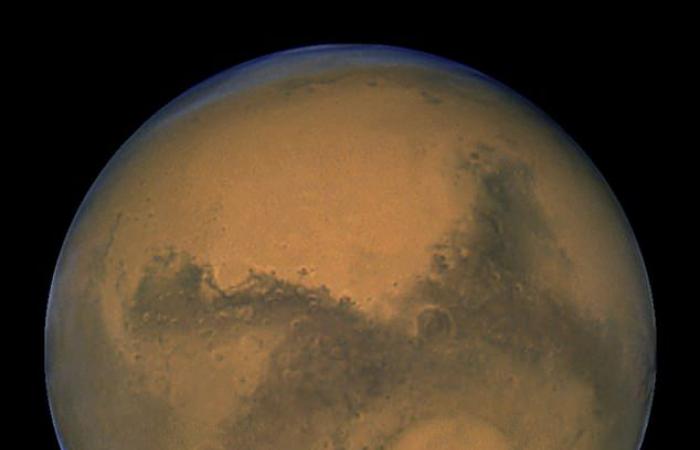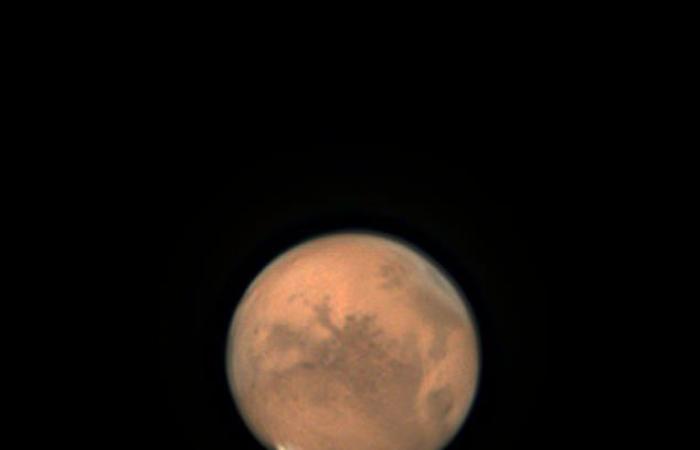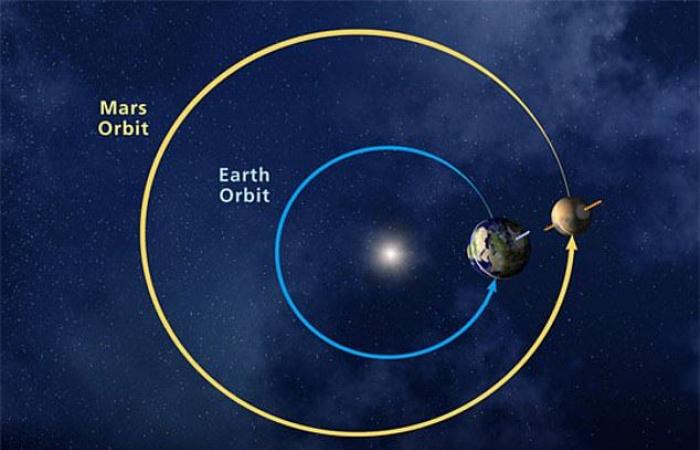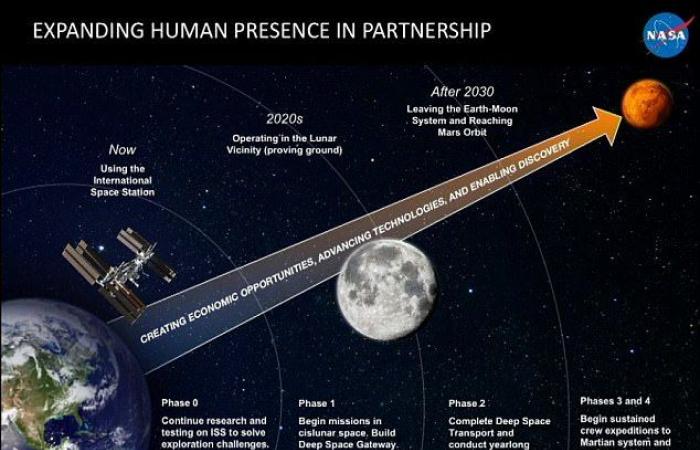Mars will appear like a bright reddish star in the night sky on Tuesday when the red planet reaches its contrast to the earth between itself and the sun.
It is visible to the naked eye and has a slightly reddish color. If you look through a telescope, you can see surface features and polar ice caps.
Mars will not appear so bright again until 2035, when the two planets are in close alignment – but should be bright by the end of October.
Although humans should see the bright orange planet by now, it will be best around 1am on Wednesday, according to the Royal Observatory Greenwich.
“It’s a really good opportunity to look – the last time this happened was in 2018, but it was pretty difficult for a lot of people to see because it was pretty low on the horizon,” said Hannah Banyard, astronomer at the Royal Observatory .
From the UK, Mars will rise above the horizon around 7:20 p.m. CET, but is best seen after midnight – to see it look east toward the constellation Pisces.
The red planet is at its point of opposition, the earth moves directly between it and the sun and, according to NASA, will “effectively appear as full Mars”


Mars is currently visible to the naked eye as a “reddish star” because it is in contrast to Earth
“It’s been pretty easy to see for about a month because it’s approaching the opposition and rising earlier, so rising from sunset and then you can see it and it’s rising pretty high in the sky, so it’s really easy to see,” said Banyard.
The opposition takes place roughly every 26 months and will not recur until 2023, although not all oppositions are created equal. This year was one of the closest since 2003.
Despite the cloudy weather forecast for parts of the United Kingdom, Mars should be visible during all breaks and even through lighter clouds, Banyard added.
“You can only see it with your eyes as a bright orange-red looking star, but I recommend using at least a 4-inch telescope with 24-millimeter magnification and then you can see some features on the surface. , She said.


To see Mars, look east towards the Pisces constellation from 7 p.m. – but preferably after midnight in an area with low light pollution


Cory Schmitz from PhotographingSpace.com took this picture of a “star-shaped” Mars that glows slightly orange in the night sky
Mars will come into opposition to Earth on Tuesday October 13 – the point at which it coincides with the Earth and the Sun – also known as “close proximity”.
“Just go outside and look up. Depending on your local weather and lighting conditions, you should be able to see Mars, ”NASA wrote in a blog post.
It reaches its closest point to the earth every two years, but not every approximation is the same, with distances varying by millions of miles even at the closest points.
The two planets are not in an exact circular orbit – so the gap gets a little closer every 15 or 17 years – this year Mars will be 38.6 million miles from Earth.
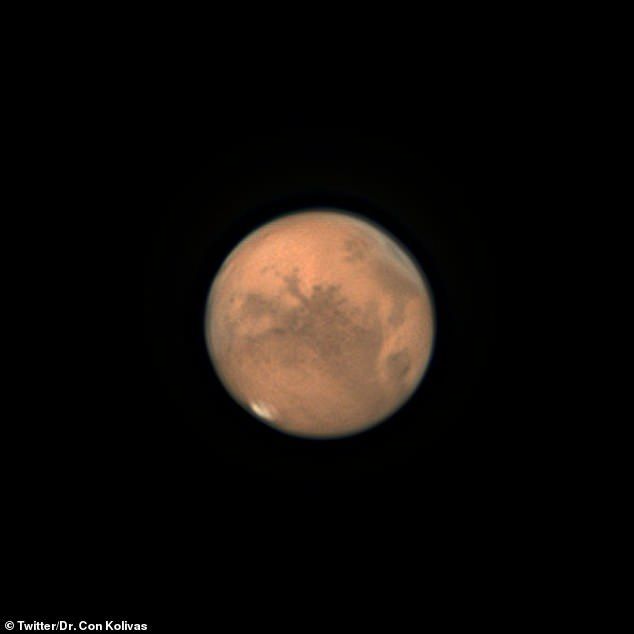

Astronomers say you can see surface features and polar regions when you look at the red planet through a telescope – like in this picture by Dr. To see Con Kolivas
The actual closest point was on October 6th due to the slightly elliptical orbit of the two planets – and not where they are directly facing each other.
This was the next approach since 2003, when Mars was 34 million miles away – the next in 60,000 years. It won’t be that close by 2287.
However, Mars will appear bright and visible to the naked eye throughout October – it won’t be that bright again until 2035.
“If Earth and Mars had perfectly circular orbits, their minimum distance would always be the same. However, they have elliptical (egg-shaped) paths, ”NASA said.
In addition, the pulling of gravity through planets is constantly changing the shape of their orbits a little. The giant Jupiter particularly affects the orbit of Mars.
“The orbits of Mars and Earth are also slightly inclined towards each other.”
Because of this, the distances between the two planets can vary by millions of miles.
“When Mars and Earth are close together, Mars appears very bright in our skies. It also makes it easier to see with telescopes or with the naked eye,” wrote NASA.
“The Red Planet is getting close enough to only be seen exceptionally well once or twice every 15 or 17 years,” and the next approach is in 2035.
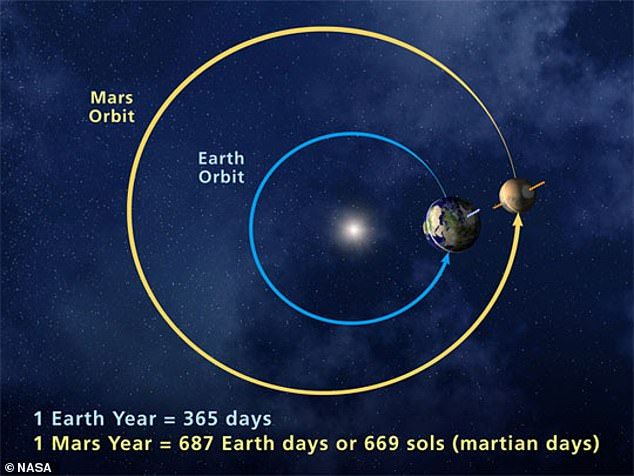

The orbits of Mars and Earth are not exactly circular and so the two planets are closer together at certain points than at other times – including this year and again in 2035
When Mars rises in the sky on Tuesday, EarthSky reports that it will appear like a “shining red star in the east” every evening and in the west before dawn.
“Mars is definitely the brightest star-shaped object that illuminates the evening sky.”
“In general, Mars is the brightest in October 2020 in 2020. It now shines brighter than the planet Jupiter, and it’s not very often that Mars outshines the king’s planet, ”EarthSky added.
There are currently three spaceships on their way from Earth to Mars – NASA’s Perseverance Rover, China’s Mars landers and orbits, and the UAE’s Hope probe.
They are all due to arrive on the Red Planet in February 2021 and provide scientists on Earth with a wealth of new information.
NASA plans to send a manned mission to Mars after the first landing on the moon in the 2030s
Mars is the next big leap in human space exploration.
But before humans reach the red planet, the astronauts will take a series of small steps by returning to the moon for a year-long mission.
Details of a mission in lunar orbit were revealed as part of a timeline of events leading up to missions to Mars in the 2030s.
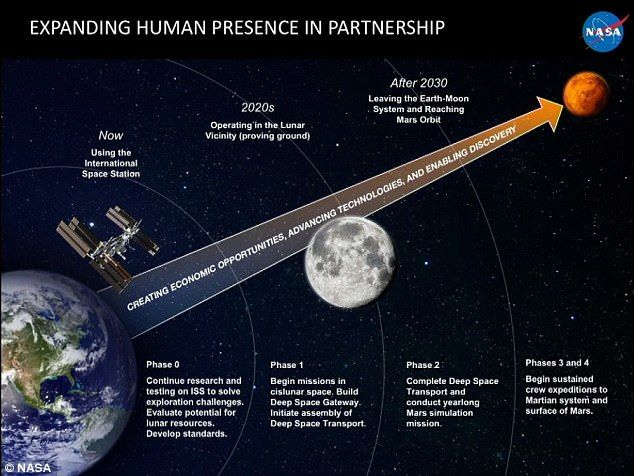

Nasa has outlined its four-step plan (pictured) that will hopefully one day allow people to visit Mars at the Humans to Mars Summit held in Washington DC yesterday. This will entail multiple missions to the moon in the coming decades
In May 2017, Greg Williams, Assistant Assistant Administrator for Policies and Plans at NASA, outlined the space agency’s four-step plan that will hopefully one day allow people to visit Mars, as well as the expected timeframe.
Phase one and two will involve multiple trips to lunar space to enable the construction of a habitat that provides a place to stay for the trip.
The last piece of hardware delivered would be the actual Deep Space Transport vehicle, which will later be used to transport a crew to Mars.
And a year-long simulation of life on Mars will be conducted in 2027.
Phases three and four begin after 2030 and include ongoing expeditions by the crew to the Mars system and surface.
These were the details of the news Mars will shine big and bright in the sky on Tuesday for this day. We hope that we have succeeded by giving you the full details and information. To follow all our news, you can subscribe to the alerts system or to one of our different systems to provide you with all that is new.
It is also worth noting that the original news has been published and is available at de24.news and the editorial team at AlKhaleej Today has confirmed it and it has been modified, and it may have been completely transferred or quoted from it and you can read and follow this news from its main source.

